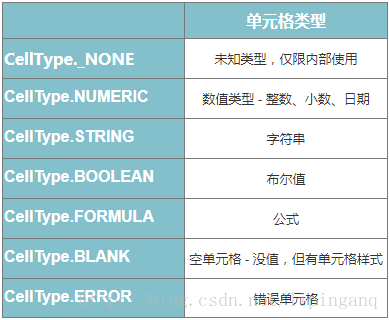POI 单元格类型CellType
1. 单元格类型
单元格的内容决定了单元格的类型,POI中定义的7种单元格类型:
- 日期数据对应的单元格类型是CellType.NUMERIC,默认以浮点型数显示,显示为日期格式需要设置单元格样式DataFormat
- 字符型单元格内容也可以为富文本RichTextString,可以对文本多部分设置字体Font
2. 错误单元格
Excel中存在错误单元格,在POI中是怎么表现的呢
org.apache.poi.ss.usermodel.FormulaError1
package org.apache.poi.ss.usermodel;import java.util.Map;import org.apache.poi.util.Internal;import java.util.HashMap;/*** Enumerates error values in SpreadsheetML formula calculations.** See also OOO's excelfileformat.pdf (2.5.6)*/public enum FormulaError {@Internal_NO_ERROR(-1, "(no error)"),/*** Intended to indicate when two areas are required to intersect, but do not.* <p>Example:* In the case of SUM(B1 C1), the space between B1 and C1 is treated as the binary* intersection operator, when a comma was intended. end example]* </p>*/NULL(0x00, "#NULL!"),/*** Intended to indicate when any number, including zero, is divided by zero.* Note: However, any error code divided by zero results in that error code.*/DIV0(0x07, "#DIV/0!"),/*** Intended to indicate when an incompatible type argument is passed to a function, or* an incompatible type operand is used with an operator.* <p>Example:* In the case of a function argument, text was expected, but a number was provided* </p>*/VALUE(0x0F, "#VALUE!"),/*** Intended to indicate when a cell reference is invalid.* <p>Example:* If a formula contains a reference to a cell, and then the row or column containing that cell is deleted,* a #REF! error results. If a worksheet does not support 20,001 columns,* OFFSET(A1,0,20000) will result in a #REF! error.* </p>*/REF(0x17, "#REF!"),/*** Intended to indicate when what looks like a name is used, but no such name has been defined.* <p>Example:* XYZ/3, where XYZ is not a defined name. Total is & A10,* where neither Total nor is is a defined name. Presumably, "Total is " & A10* was intended. SUM(A1C10), where the range A1:C10 was intended.* </p>*/NAME(0x1D, "#NAME?"),/*** Intended to indicate when an argument to a function has a compatible type, but has a* value that is outside the domain over which that function is defined. (This is known as* a domain error.)* <p>Example:* Certain calls to ASIN, ATANH, FACT, and SQRT might result in domain errors.* </p>* Intended to indicate that the result of a function cannot be represented in a value of* the specified type, typically due to extreme magnitude. (This is known as a range* error.)* <p>Example: FACT(1000) might result in a range error. </p>*/NUM(0x24, "#NUM!"),/*** Intended to indicate when a designated value is not available.* <p>Example:* Some functions, such as SUMX2MY2, perform a series of operations on corresponding* elements in two arrays. If those arrays do not have the same number of elements, then* for some elements in the longer array, there are no corresponding elements in the* shorter one; that is, one or more values in the shorter array are not available.* </p>* This error value can be produced by calling the function NA*/NA(0x2A, "#N/A"),// These are POI-specific error codes// It is desirable to make these (arbitrary) strings look clearly different from any other// value expression that might appear in a formula. In addition these error strings should// look unlike the standard Excel errors. Hence tilde ('~') was used./*** POI specific code to indicate that there is a circular reference* in the formula*/CIRCULAR_REF(0xFFFFFFC4, "~CIRCULAR~REF~"),/*** POI specific code to indicate that the funcition required is* not implemented in POI*/FUNCTION_NOT_IMPLEMENTED(0xFFFFFFE2, "~FUNCTION~NOT~IMPLEMENTED~");private final byte type;private final int longType;private final String repr;private FormulaError(int type, String repr) {this.type = (byte)type;this.longType = type;this.repr = repr;}/*** @return numeric code of the error*/public byte getCode() {return type;}/*** @return long (internal) numeric code of the error*/public int getLongCode() {return longType;}/*** @return string representation of the error*/public String getString() {return repr;}private static final Map<String, FormulaError> smap = new HashMap<String, FormulaError>();private static final Map<Byte, FormulaError> bmap = new HashMap<Byte, FormulaError>();private static final Map<Integer, FormulaError> imap = new HashMap<Integer, FormulaError>();static{for (FormulaError error : values()) {bmap.put(error.getCode(), error);imap.put(error.getLongCode(), error);smap.put(error.getString(), error);}}public static final boolean isValidCode(int errorCode) {for (FormulaError error : values()) {if (error.getCode() == errorCode) return true;if (error.getLongCode() == errorCode) return true;}return false;}public static FormulaError forInt(byte type) throws IllegalArgumentException {FormulaError err = bmap.get(type);if(err == null) throw new IllegalArgumentException("Unknown error type: " + type);return err;}public static FormulaError forInt(int type) throws IllegalArgumentException {FormulaError err = imap.get(type);if(err == null) err = bmap.get((byte)type);if(err == null) throw new IllegalArgumentException("Unknown error type: " + type);return err;}public static FormulaError forString(String code) throws IllegalArgumentException {FormulaError err = smap.get(code);if(err == null) throw new IllegalArgumentException("Unknown error code: " + code);return err;}}
3. 实例
package hssf.sheet.cell;import java.io.BufferedOutputStream;import java.io.File;import java.io.FileOutputStream;import java.io.IOException;import java.util.Calendar;import java.util.Date;import org.apache.poi.hssf.usermodel.HSSFWorkbook;import org.apache.poi.ss.usermodel.CellType;import org.apache.poi.ss.usermodel.Sheet;import org.apache.poi.ss.usermodel.Workbook;public class ExportDataCell {public static void main(String[] args) throws Exception {File file = new File("C:\\Users\\Administrator\\Desktop\\test.xls");if (file.exists()) {file.delete();}BufferedOutputStream out = null;try {out = new BufferedOutputStream(new FileOutputStream("C:\\Users\\Administrator\\Desktop\\test.xls"));exportExcel(out);} finally {out.close();}}private static void exportExcel(BufferedOutputStream out) throws IOException {Workbook wb = new HSSFWorkbook();//Workbook wb = new XSSFWorkbook();Sheet sheet = wb.createSheet("各种类型单元格");sheet.createRow(0).createCell(0).setCellValue(1.1);sheet.createRow(1).createCell(0).setCellValue(new Date());sheet.createRow(2).createCell(0).setCellValue(Calendar.getInstance());sheet.createRow(3).createCell(0).setCellValue("字符串");sheet.createRow(4).createCell(0).setCellValue(true);sheet.createRow(5).createCell(0).setCellType(CellType.ERROR);wb.write(out);}}
版权说明 : 本文为转载文章, 版权归原作者所有 版权申明
原文链接 : https://lebron.blog.csdn.net/article/details/123905709
内容来源于网络,如有侵权,请联系作者删除!


